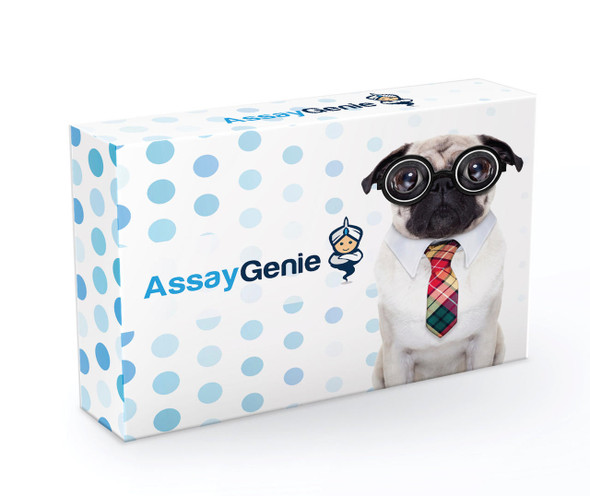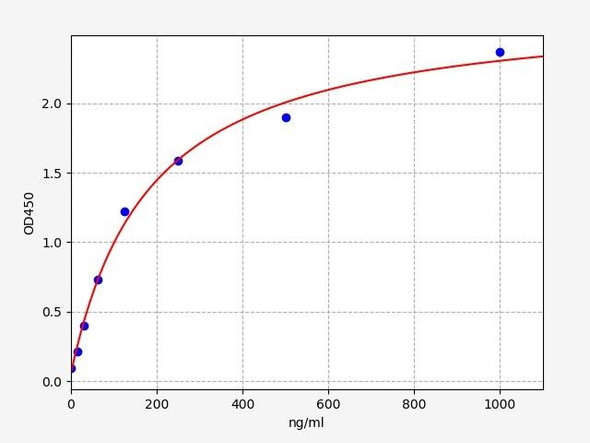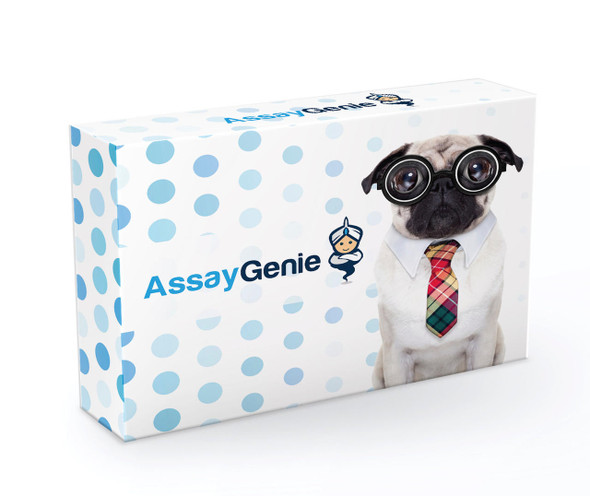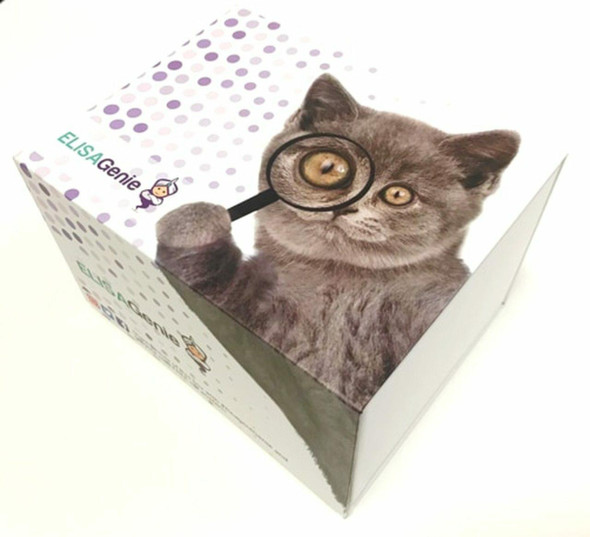Rat Haptoglobin (Hp) ELISA Kit (RTEB0468)
- SKU:
- RTEB0468
- Product Type:
- ELISA Kit
- Size:
- 96 Assays
- Uniprot:
- P06866
- Range:
- 7.8-500 ng/mL
- ELISA Type:
- Sandwich
- Synonyms:
- Hp, HP, HP-1, hp2-alpha, HPA1S, binding peptide, BP, haptoglobin, haptoglobin alpha, 1S-beta, haptoglobin alpha, 2FS-beta, haptoglobin, alpha polypeptide, haptoglobin, beta polypeptide, HPA1S
- Reactivity:
- Rat
Description
Rat Haptoglobin (Hp) ELISA Kit
The Rat Haptoglobin (Hp) ELISA Kit is specifically designed for the precise measurement of haptoglobin levels in rat serum, plasma, and cell culture supernatants. With its high sensitivity and specificity, this kit provides accurate and consistent results, making it an excellent choice for various research applications.Haptoglobin is a key protein involved in the acute-phase response, binding free hemoglobin to prevent oxidative damage and promote immune regulation. Dysregulation of haptoglobin levels has been linked to inflammatory conditions, liver disease, and cardiovascular disorders, highlighting its importance as a biomarker for disease research and therapeutic development.
With the Rat Haptoglobin (Hp) ELISA Kit, researchers can effectively study haptoglobin levels in rat samples, gaining valuable insights into the role of haptoglobin in different physiological and pathological processes. Trust this kit for reliable and robust data to support your research objectives.
| Product Name: | Rat Haptoglobin (Hp) ELISA Kit |
| SKU: | RTEB0468 |
| Size: | 96T |
| Target: | Rat Haptoglobin (Hp) |
| Synonyms: | Liver regeneration-related protein LRRG173, Ba1-647 |
| Assay Type: | Sandwich |
| Detection Method: | ELISA |
| Reactivity: | Rat |
| Detection Range: | 7.8-500ng/mL |
| Sensitivity: | 3.99ng/mL |
| Intra CV: | 5.3% | ||||||||||||||||||||
| Inter CV: | 8.6% | ||||||||||||||||||||
| Linearity: |
| ||||||||||||||||||||
| Recovery: |
| ||||||||||||||||||||
| Function: | As a result of hemolysis, hemoglobin is found to accumulate in the kidney and is secreted in the urine. Haptoglobin captures, and combines with free plasma hemoglobin to allow hepatic recycling of heme iron and to prevent kidney damage. Haptoglobin also acts as an antioxidant, has antibacterial activity and plays a role in modulating many aspects of the acute phase response. Hemoglobin/haptoglobin complexes are rapidly cleared by the macrophage CD163 scavenger receptor expressed on the surface of liver Kupfer cells through an endocytic lysosomal degradation pathway (By similarity). |
| Uniprot: | P06866 |
| Sample Type: | Serum, plasma, tissue homogenates, cell culture supernates and other biological fluids |
| Specificity: | Natural and recombinant rat Haptoglobin |
| Sub Unit: | Tetramer of two alpha and two beta chains; disulfide-linked. The hemoglobin/haptoglobin complex is composed of a haptoglobin dimer bound to two hemoglobin alpha-beta dimers. Interacts with CD163 (By similarity). |
| Research Area: | Cardiovascular |
| Subcellular Location: | Secreted |
| Storage: | Please see kit components below for exact storage details |
| Note: | For research use only |
| UniProt Protein Function: | HP: Haptoglobin combines with free plasma hemoglobin, preventing loss of iron through the kidneys and protecting the kidneys from damage by hemoglobin, while making the hemoglobin accessible to degradative enzymes. Defects in HP are the cause of anhaptoglobinemia (AHP). AHP is a condition characterized by the absence of the serum glycoprotein haptoglobin. Serum levels of haptoglobin vary among normal persons: levels are low in the neonatal period and in the elderly, differ by population, and can be influenced by environmental factors, such as infection. Secondary hypohaptoglobinemia can occur as a consequence of hemolysis, during which haptoglobin binds to free hemoglobin. Belongs to the peptidase S1 family. |
| UniProt Protein Details: | Protein type:Enzyme, misc.; Protease; Endoplasmic reticulum; Secreted, signal peptide; Secreted Cellular Component: endoplasmic reticulum; extracellular region; extracellular space; Golgi apparatus Molecular Function:antioxidant activity; hemoglobin binding; protein homodimerization activity; serine-type endopeptidase activity Biological Process: acute inflammatory response; acute-phase response; defense response to bacterium; immune system process; liver development; negative regulation of oxidoreductase activity; Notch signaling pathway; organ regeneration; proteolysis; response to cobalamin; response to drug; response to electrical stimulus; response to glucocorticoid stimulus; response to heat; response to hydrogen peroxide; response to hypoxia; response to L-ascorbic acid; response to lead ion; response to lipopolysaccharide; response to magnesium ion; response to organic cyclic substance; response to organic substance; response to X-ray; spermatogenesis |
| NCBI Summary: | may bind hemoglobin and mediate hemoglobin catabolism in lung cells; may play a role in inflammatory response [RGD, Feb 2006] |
| UniProt Code: | P06866 |
| NCBI GenInfo Identifier: | 60097941 |
| NCBI Gene ID: | 24464 |
| NCBI Accession: | NP_036714.2 |
| UniProt Secondary Accession: | P06866,Q5EBB4, Q7TP23, |
| UniProt Related Accession: | P06866 |
| Molecular Weight: | 40.5 kDa |
| NCBI Full Name: | haptoglobin |
| NCBI Synonym Full Names: | haptoglobin |
| NCBI Official Symbol: | Hp |
| NCBI Official Synonym Symbols: | Ba1-647 |
| NCBI Protein Information: | haptoglobin |
| UniProt Protein Name: | Haptoglobin |
| UniProt Synonym Protein Names: | Liver regeneration-related protein LRRG173; Zonulin |
| UniProt Gene Name: | Hp |
| UniProt Entry Name: | HPT_RAT |
| Component | Quantity (96 Assays) | Storage |
| ELISA Microplate (Dismountable) | 8×12 strips | -20°C |
| Lyophilized Standard | 2 | -20°C |
| Sample Diluent | 20ml | -20°C |
| Assay Diluent A | 10mL | -20°C |
| Assay Diluent B | 10mL | -20°C |
| Detection Reagent A | 120µL | -20°C |
| Detection Reagent B | 120µL | -20°C |
| Wash Buffer | 30mL | 4°C |
| Substrate | 10mL | 4°C |
| Stop Solution | 10mL | 4°C |
| Plate Sealer | 5 | - |
Other materials and equipment required:
- Microplate reader with 450 nm wavelength filter
- Multichannel Pipette, Pipette, microcentrifuge tubes and disposable pipette tips
- Incubator
- Deionized or distilled water
- Absorbent paper
- Buffer resevoir
*Note: The below protocol is a sample protocol. Protocols are specific to each batch/lot. For the correct instructions please follow the protocol included in your kit.
Allow all reagents to reach room temperature (Please do not dissolve the reagents at 37°C directly). All the reagents should be mixed thoroughly by gently swirling before pipetting. Avoid foaming. Keep appropriate numbers of strips for 1 experiment and remove extra strips from microtiter plate. Removed strips should be resealed and stored at -20°C until the kits expiry date. Prepare all reagents, working standards and samples as directed in the previous sections. Please predict the concentration before assaying. If values for these are not within the range of the standard curve, users must determine the optimal sample dilutions for their experiments. We recommend running all samples in duplicate.
| Step | |
| 1. | Add Sample: Add 100µL of Standard, Blank, or Sample per well. The blank well is added with Sample diluent. Solutions are added to the bottom of micro ELISA plate well, avoid inside wall touching and foaming as possible. Mix it gently. Cover the plate with sealer we provided. Incubate for 120 minutes at 37°C. |
| 2. | Remove the liquid from each well, don't wash. Add 100µL of Detection Reagent A working solution to each well. Cover with the Plate sealer. Gently tap the plate to ensure thorough mixing. Incubate for 1 hour at 37°C. Note: if Detection Reagent A appears cloudy warm to room temperature until solution is uniform. |
| 3. | Aspirate each well and wash, repeating the process three times. Wash by filling each well with Wash Buffer (approximately 400µL) (a squirt bottle, multi-channel pipette,manifold dispenser or automated washer are needed). Complete removal of liquid at each step is essential. After the last wash, completely remove remaining Wash Buffer by aspirating or decanting. Invert the plate and pat it against thick clean absorbent paper. |
| 4. | Add 100µL of Detection Reagent B working solution to each well. Cover with the Plate sealer. Incubate for 60 minutes at 37°C. |
| 5. | Repeat the wash process for five times as conducted in step 3. |
| 6. | Add 90µL of Substrate Solution to each well. Cover with a new Plate sealer and incubate for 10-20 minutes at 37°C. Protect the plate from light. The reaction time can be shortened or extended according to the actual color change, but this should not exceed more than 30 minutes. When apparent gradient appears in standard wells, user should terminatethe reaction. |
| 7. | Add 50µL of Stop Solution to each well. If color change does not appear uniform, gently tap the plate to ensure thorough mixing. |
| 8. | Determine the optical density (OD value) of each well at once, using a micro-plate reader set to 450 nm. User should open the micro-plate reader in advance, preheat the instrument, and set the testing parameters. |
| 9. | After experiment, store all reagents according to the specified storage temperature respectively until their expiry. |
When carrying out an ELISA assay it is important to prepare your samples in order to achieve the best possible results. Below we have a list of procedures for the preparation of samples for different sample types.
| Sample Type | Protocol |
| Serum | If using serum separator tubes, allow samples to clot for 30 minutes at room temperature. Centrifuge for 10 minutes at 1,000x g. Collect the serum fraction and assay promptly or aliquot and store the samples at -80°C. Avoid multiple freeze-thaw cycles. If serum separator tubes are not being used, allow samples to clot overnight at 2-8°C. Centrifuge for 10 minutes at 1,000x g. Remove serum and assay promptly or aliquot and store the samples at -80°C. Avoid multiple freeze-thaw cycles. |
| Plasma | Collect plasma using EDTA or heparin as an anticoagulant. Centrifuge samples at 4°C for 15 mins at 1000 × g within 30 mins of collection. Collect the plasma fraction and assay promptly or aliquot and store the samples at -80°C. Avoid multiple freeze-thaw cycles. Note: Over haemolysed samples are not suitable for use with this kit. |
| Urine & Cerebrospinal Fluid | Collect the urine (mid-stream) in a sterile container, centrifuge for 20 mins at 2000-3000 rpm. Remove supernatant and assay immediately. If any precipitation is detected, repeat the centrifugation step. A similar protocol can be used for cerebrospinal fluid. |
| Cell culture supernatant | Collect the cell culture media by pipette, followed by centrifugation at 4°C for 20 mins at 1500 rpm. Collect the clear supernatant and assay immediately. |
| Cell lysates | Solubilize cells in lysis buffer and allow to sit on ice for 30 minutes. Centrifuge tubes at 14,000 x g for 5 minutes to remove insoluble material. Aliquot the supernatant into a new tube and discard the remaining whole cell extract. Quantify total protein concentration using a total protein assay. Assay immediately or aliquot and store at ≤ -20 °C. |
| Tissue homogenates | The preparation of tissue homogenates will vary depending upon tissue type. Rinse tissue with 1X PBS to remove excess blood & homogenize in 20ml of 1X PBS (including protease inhibitors) and store overnight at ≤ -20°C. Two freeze-thaw cycles are required to break the cell membranes. To further disrupt the cell membranes you can sonicate the samples. Centrifuge homogenates for 5 mins at 5000xg. Remove the supernatant and assay immediately or aliquot and store at -20°C or -80°C. |
| Tissue lysates | Rinse tissue with PBS, cut into 1-2 mm pieces, and homogenize with a tissue homogenizer in PBS. Add an equal volume of RIPA buffer containing protease inhibitors and lyse tissues at room temperature for 30 minutes with gentle agitation. Centrifuge to remove debris. Quantify total protein concentration using a total protein assay. Assay immediately or aliquot and store at ≤ -20 °C. |
| Breast Milk | Collect milk samples and centrifuge at 10,000 x g for 60 min at 4°C. Aliquot the supernatant and assay. For long term use, store samples at -80°C. Minimize freeze/thaw cycles. |








